Have you ever come across a black and yellow striped caterpillar munching away in your garden and wondered, “What kind is that?” Those distinctive black and yellow bands are a common color pattern found in many caterpillar species. While sometimes alarming due to their resemblance to stinging insects, these caterpillars are actually harmless.
In this guide, we’ll explore some of the most common black and yellow caterpillar varieties you might encounter, along with tips on how to identify them. From the iconic monarch to the formidable hawk moth caterpillars, these colorful garden guests have some fascinating quirks and caterpillar-to-butterfly transformations in store!
1. Monarch Caterpillar

Here is a concise information chart about Monarch caterpillars:
| Category | Information |
|---|---|
| Scientific Name | Danaus plexippus |
| Common Name | Monarch caterpillar |
| Life Stage | Larva (caterpillar stage) of the Monarch butterfly |
| Appearance | Black, white, and yellow striped body |
| Size | Up to 2 inches (5 cm) long when fully grown |
| Habitat | Found primarily on milkweed plants in North America |
| Diet | Exclusively feeds on milkweed leaves |
| Significance | Consuming milkweed makes them toxic to predators |
| Development Stages | Egg, five instars (larval stages), pupa (chrysalis), adult butterfly |
| Predators | Birds, spiders, and parasitic wasps |
| Migration | Part of the migratory species that travel to Mexico for the winter as adults |
| Defense Mechanism | Bright coloration serves as a warning to predators about their toxicity |
| Conservation Status | Not endangered, but populations are declining due to habitat loss and pesticide use |
Let’s start with arguably the most well-known of the black and yellow crew – the monarch caterpillar. With its striking black bands, yellow stripes, and pair of black antennae up front, this instantly recognizable caterpillar is hard to miss.
Monarch caterpillars are utterly dependent on milkweed plants, which they eat voraciously and which provide protection from predators thanks to toxic compounds in the leaves. They’ll happily defoliate entire milkweed patches during their caterpillar stage!
2. Swallowtail Caterpillars
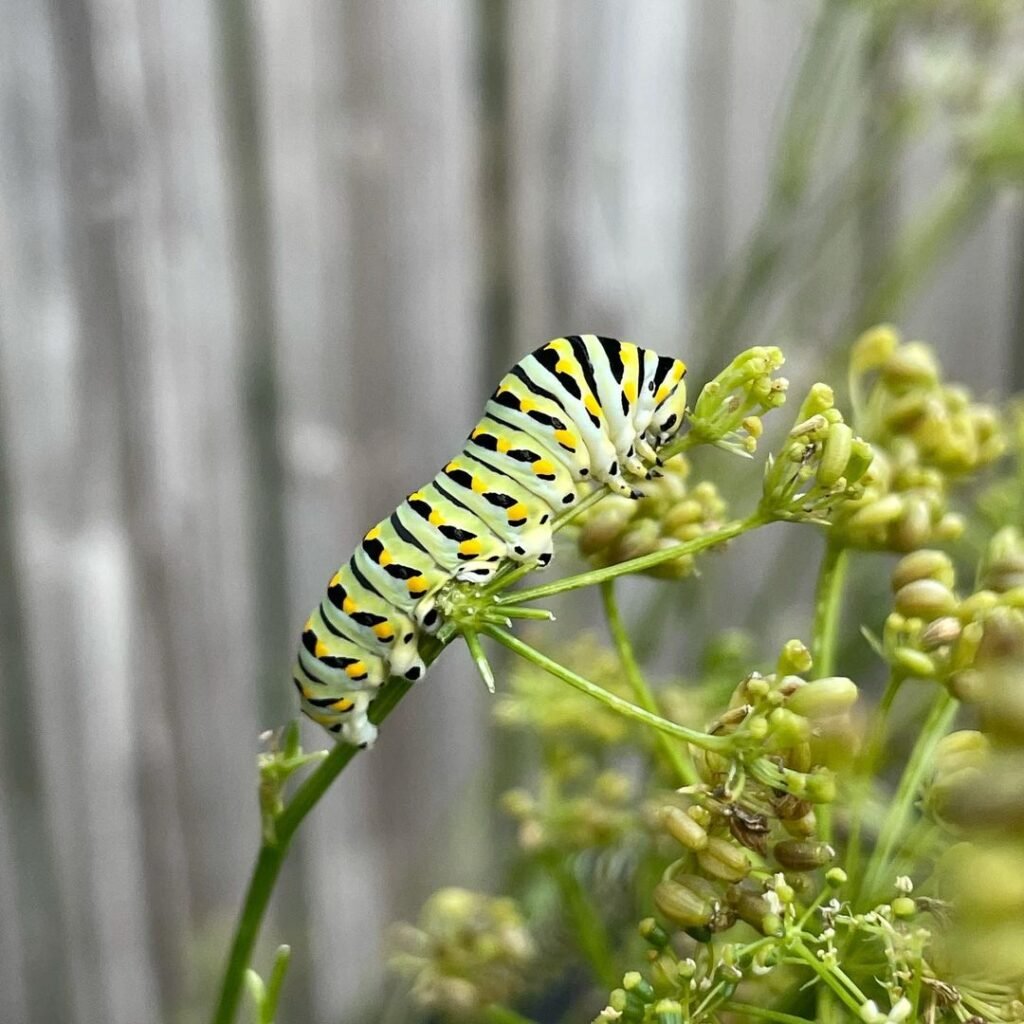
Here’s a concise information chart about Swallowtail caterpillars:
| Category | Information |
|---|---|
| Scientific Name | Family: Papilionidae (various species, e.g., Papilio polyxenes for Black Swallowtail) |
| Common Name | Swallowtail caterpillar |
| Life Stage | Larva (caterpillar stage) of Swallowtail butterflies |
| Appearance | Varies by species; commonly green with black stripes and yellow or orange spots |
| Size | Up to 2 inches (5 cm) long when fully grown |
| Habitat | Found in a variety of habitats including gardens, meadows, and woodlands |
| Diet | Feeds on host plants; species-specific (e.g., parsley, dill, fennel for Black Swallowtail) |
| Significance | Often considered beneficial insects for pollination and aesthetic value |
| Development Stages | Egg, five instars (larval stages), pupa (chrysalis), adult butterfly |
| Predators | Birds, spiders, and parasitic wasps |
| Defense Mechanism | Some species have an osmeterium (glandular organ) that emits foul smells to deter predators |
| Migration | Not typically migratory, but some species may disperse over large areas |
| Conservation Status | Generally not endangered, but some species may face threats from habitat loss and pesticides |
Another common sight in summer gardens across the United States are the caterpillars of our various swallowtail butterfly species. Two of the most widespread types have black and yellow striped forms – the eastern black swallowtail and the anise swallowtail.
Eastern black swallowtail caterpillars are jet black with yellow bands encircling their plump bodies. The coloring mimics a snake, giving them protection from potential predators. As caterpillars, they feed on plants in the carrot family like dill, fennel, and parsley.
Anise swallowtail caterpillars display similar black and yellow markings, but with a more yellow base color and black bands across each segment. True to their name, their host plants include anise, dill, and fennel.
3. Woolly Bear Caterpillar
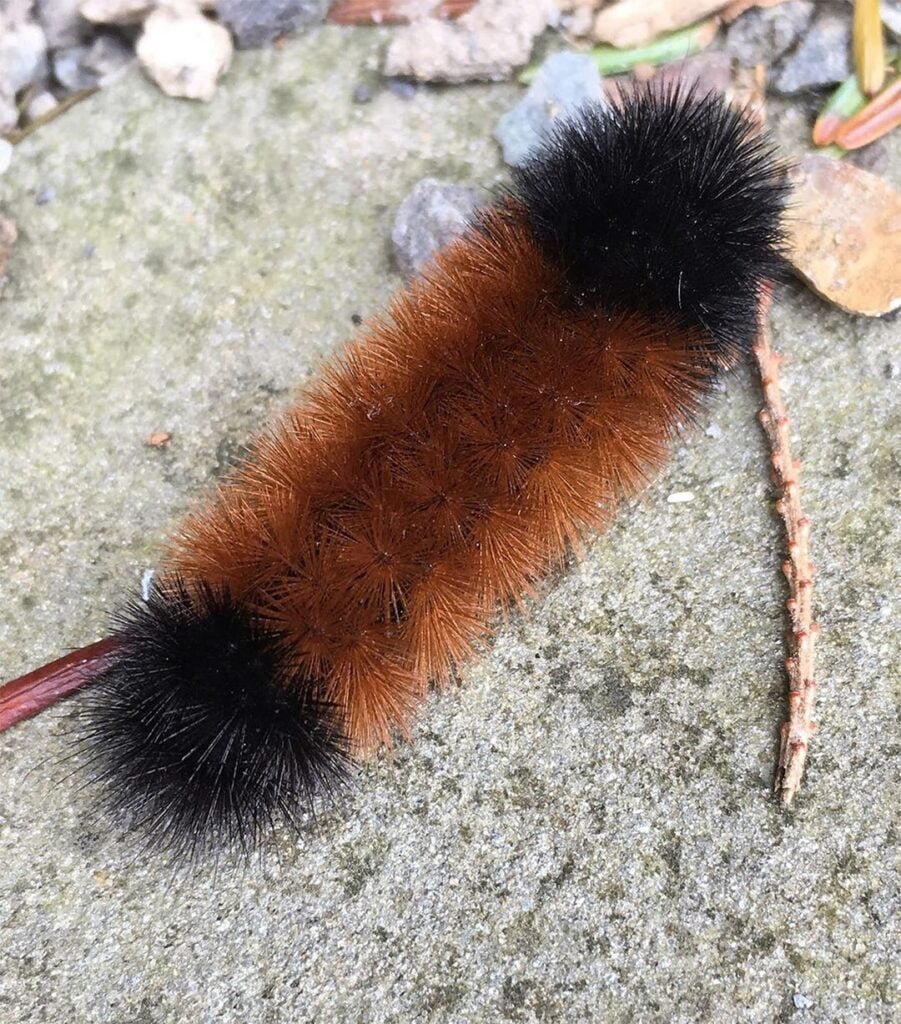
Here is a concise information chart about Woolly Bear caterpillars:
| Category | Information |
|---|---|
| Scientific Name | Pyrrharctia isabella |
| Common Name | Woolly Bear caterpillar, Banded Woolly Bear |
| Life Stage | Larva (caterpillar stage) of the Isabella Tiger Moth |
| Appearance | Distinctive black and orange-brown bands (black at both ends and orange in the middle) |
| Size | Up to 2 inches (5 cm) long when fully grown |
| Habitat | Found in various habitats including gardens, meadows, and forests |
| Diet | Feeds on a wide variety of plants including grasses, herbs, and leaves of trees |
| Significance | Folklore suggests they can predict winter severity by their band length |
| Development Stages | Egg, larva (Woolly Bear), pupa (cocoon), adult moth |
| Predators | Birds, small mammals, and parasitoid insects |
| Defense Mechanism | Roll into a tight ball to protect from predators and can produce irritating hairs |
| Migration | Not migratory; overwinters in caterpillar form, often under leaf litter or bark |
| Conservation Status | Not endangered; commonly found and widespread |
No list of striped caterpillars would be complete without mentioning the famous “woolly bear” – the larval form of the Isabella tiger moth. A thick coat of bristly, tawny-brown fur covers most of the woolly bear’s body, but the iconic black and reddish-brown banding is hard to miss.
According to folklore, the width of the reddish-brown band on a woolly bear can predict the severity of the coming winter. The wider the band, the milder the cold weather will be. While unproven, it’s still fun to look for these caterpillars each fall!
4. Waved Sphinx Moth Caterpillar
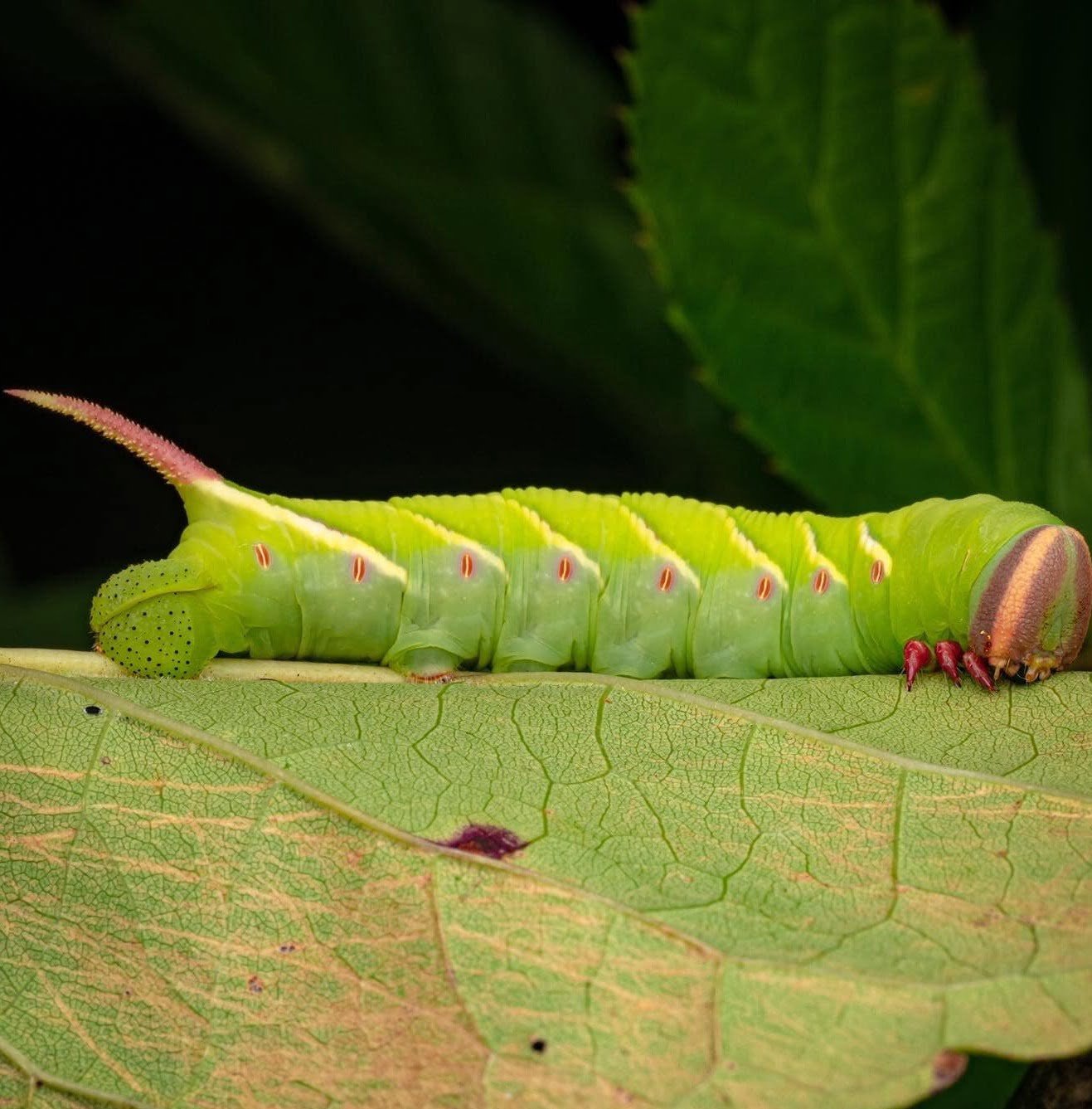
Here is a concise information chart about Waved Sphinx Moth caterpillars:
| Category | Information |
|---|---|
| Scientific Name | Ceratomia undulosa |
| Common Name | Waved Sphinx Moth caterpillar |
| Life Stage | Larva (caterpillar stage) of the Waved Sphinx Moth |
| Appearance | Green with white stripes and a distinctive horn (caudal horn) on the rear end |
| Size | Up to 3 inches (7.5 cm) long when fully grown |
| Habitat | Found in forests, woodlands, and areas with host plants |
| Diet | Feeds on leaves of trees and shrubs, especially ash, fringe tree, lilac, and privet |
| Significance | Important for the ecosystem as both a herbivore and prey for other animals |
| Development Stages | Egg, larva (caterpillar), pupa, adult moth |
| Predators | Birds, bats, small mammals, and parasitic wasps |
| Defense Mechanism | Camouflage and the caudal horn which can deter predators |
| Migration | Not migratory; undergoes pupation in the soil |
| Conservation Status | Not endangered; commonly found in suitable habitats |
As we move into the hawk moth family, we see several species of black and yellow striped caterpillars that are as beautiful as they are intimidatingly large! The waved sphinx moth caterpillar is a perfect example, sporting thick yellow bands against a black body and a curved horn protrusion at its rear end.
When fully grown, this chunky caterpillar can reach nearly 4 inches long. Don’t be alarmed by the snake-like head movements and horn though – it’s just for show as these caterpillars are completely harmless. They’re commonly found feeding on plants like elm, birch, ash, and lilac trees.
5. Tersa Sphinx Moth Caterpillar
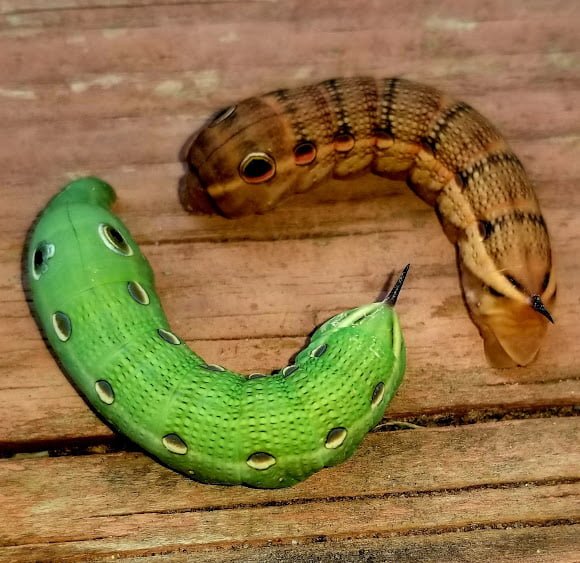
Here is a concise information chart about Tersa Sphinx Moth caterpillars:
| Category | Information |
|---|---|
| Scientific Name | Xylophanes tersa |
| Common Name | Tersa Sphinx Moth caterpillar |
| Life Stage | Larva (caterpillar stage) of the Tersa Sphinx Moth |
| Appearance | Green or brown with distinctive eye spots on the third segment, tapering body shape |
| Size | Up to 3 inches (7.5 cm) long when fully grown |
| Habitat | Found in gardens, open fields, and areas with host plants |
| Diet | Feeds on leaves of plants such as pentas, catalpa, and madder |
| Significance | Noted for their rapid growth and distinct eye spots which may deter predators |
| Development Stages | Egg, larva (caterpillar), pupa, adult moth |
| Predators | Birds, spiders, and parasitic wasps |
| Defense Mechanism | Eye spots mimic the eyes of a snake, providing a form of predator deterrence |
| Migration | Not migratory; develops and pupates within the same general area |
| Conservation Status | Not endangered; populations are stable |
Another heavy-bodied hawk moth caterpillar with striking black and yellow colorations is the larva of the tersa sphinx moth. These plump caterpillars sport a series of yellow bands separated by black segments, each lined with six curved spines.
Perhaps the tersa sphinx caterpillar’s most distinctive feature is its reddish or pinkish coloring towards the head, ending in a curved horn just like their waved sphinx cousins. Trees like elm and ash provide food sources for these eye-catching larvae.
6. Azalea Caterpillar or Rhododendron Borer
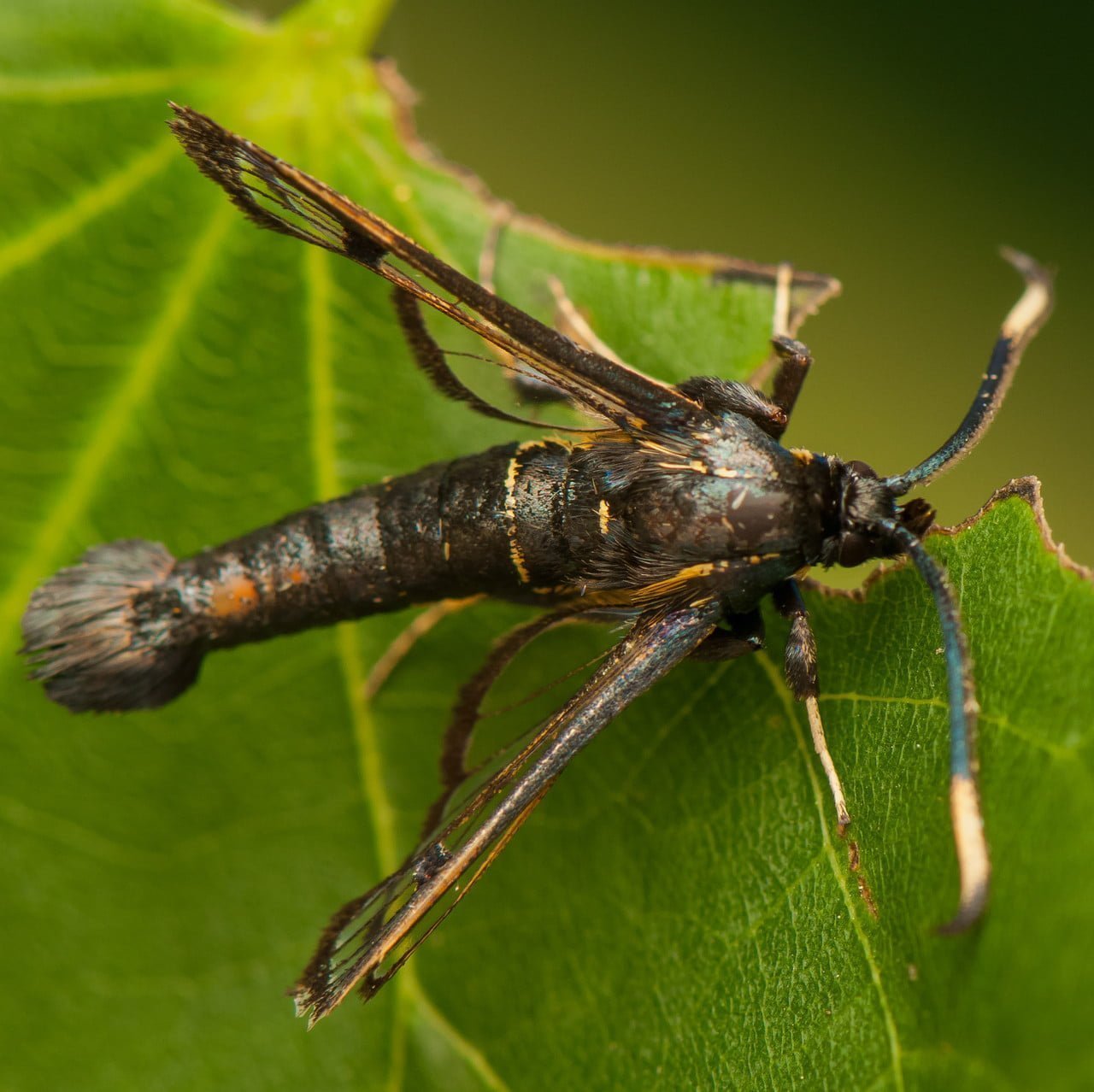
Here is a concise information chart about Azalea caterpillars :
| Category | Information |
|---|---|
| Scientific Name | Datana major |
| Common Name | Azalea caterpillar |
| Life Stage | Larva (caterpillar stage) of a moth |
| Appearance | Brightly colored with black, yellow, and red stripes; red head and legs |
| Size | Up to 2 inches (5 cm) long when fully grown |
| Habitat | Found on azalea bushes in gardens and landscapes |
| Diet | Feeds primarily on azalea leaves |
| Significance | Can cause significant defoliation of azalea plants |
| Development Stages | Egg, larva (caterpillar), pupa, adult moth |
| Predators | Birds, spiders, and parasitic wasps |
| Defense Mechanism | Group feeding and bright coloration to warn predators of potential toxicity |
| Migration | Not migratory; remains on or near host plants |
| Conservation Status | Not endangered; can be a pest in ornamental gardens |
While the fuzzy azalea caterpillar might look cuddly at first glance, gardeners don’t love finding this distinctive black and yellow caterpillar munching on their cherished azaleas, rhododendrons, or mountain laurels. Their alternating yellow and black bands are encircled by rows of fine golden bristles.
Azalea caterpillars are the larvae of a type of clear-winged moth. Beyond stripping plants of their vegetation, they can also wreak havoc by boring into the trunks and branches of their host plants.
7. Spotted Tussock Moth Caterpillar
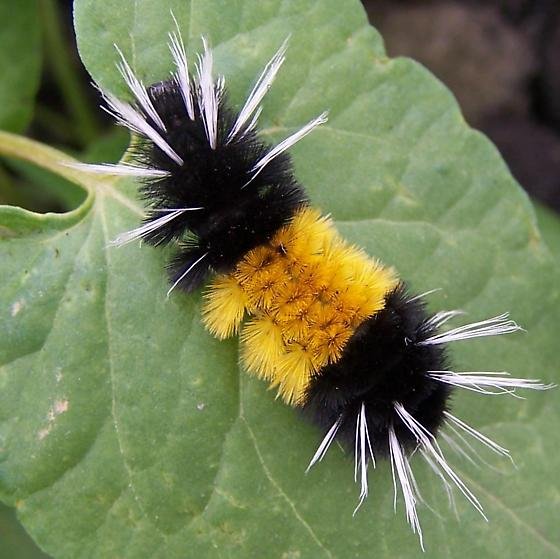
Here is a concise information chart about the Spotted Tussock Moth caterpillar:
| Category | Information |
|---|---|
| Scientific Name | Lophocampa maculata |
| Common Name | Spotted Tussock Moth caterpillar, Yellow-Spotted Tiger Moth caterpillar |
| Life Stage | Larva (caterpillar stage) of the Spotted Tussock Moth |
| Appearance | Furry caterpillar with distinctive yellow and black tufts of hair; white spots on black sections |
| Size | Up to 1.5 inches (3.8 cm) long when fully grown |
| Habitat | Found in forests, woodlands, and areas with host plants |
| Diet | Feeds on a variety of deciduous trees and shrubs, including birch, willow, and oak |
| Significance | Part of the forest ecosystem, serving as food for predators and aiding in plant health management |
| Development Stages | Egg, larva (caterpillar), pupa (cocoon), adult moth |
| Predators | Birds, small mammals, and parasitoid insects |
| Defense Mechanism | Furry appearance can deter predators; some hairs may cause irritation to human skin |
| Migration | Not migratory; remains in or near habitat with host plants |
| Conservation Status | Not endangered; commonly found in suitable habitats |
You’ll have no trouble distinguishing the spotted tussock moth caterpillar thanks to its fuzzy black body, bright yellow markings, and long tufts of spiny hairs protruding from its sides. These sharp bristles deliver a painful sting, so admire this caterpillar from a distance!
Spotted tussock caterpillars feed on a wide range of hardwood trees including oaks, willows, and maples. Their diet enables them to spread rapidly to new areas. Control is rarely needed though, as natural predators and diseases prevent widespread outbreaks.
While these caterpillars may look downright fearsome, most are harmless unless handled. In fact, their bold black and yellow stripes act as warning signs to predators that they could be poisonous or distasteful, so it’s best to simply admire their intricate designs from afar.
Next time you spot a black and yellow caterpillar crawling its way across a leaf, take a moment to stop and identify what fascinating species might be visiting your garden. Who knows, you may even get a glimpse of its full metamorphosis into an eye-catching butterfly or moth! These tiny eating machines show that nature is full of beautiful surprises, even in the humblest of forms.
Pingback: https://gardenersschool.com/black-and-yellow-ca...
Pingback: 15 Black and Orange Caterpillars (With Pictures) -
Pingback: 10 Texas Caterpillars: A Visual Identification Guide -
Pingback: Philodendron Spiritus Sancti Indoor Plant Growing Guide - Gardener's School